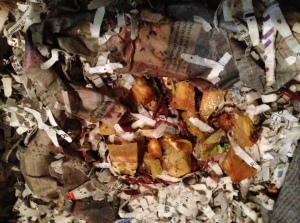Plants need water, sun, soil, and space to survive and thrive. Water and sun can be fairly easy to manage, but soil isn’t always that way. Garden soil needs to have a certain amount of vitamins and minerals, like nitrogen, potassium, and phosphate in order to support healthy plants. Though I have hit the aisles of Home Depot for the packaged mixtures, my soil improvement operation is mainly two fold: composting and vermicomposting.
Compost Happens
My family first began to compost with two goals:
- to reduce the amount of ‘trash’ we sent to the landfill
- to create fertile soil to add to our garden.
At our first house, we dumped our kitchen scraps in a tomato wire cage. We watched the food disintegrate and the rats multiply. (We lived close to several restaurants on a city block.) No success on creating the soil!
In this current house, we live in a neighborhood with a larger yard. No rats, but plenty of squirrels. With this in mind but no researched compost bin philosophy, my husband constructed a wooden bin lined with chicken wire high enough to protect it from kids and animals. (There was no need for this precaution.) Over the past three years, we have dumped our kitchen scraps, grass clippings, and dry leaves into this bin. It is important to have a combination of both green and brown waste. Every day or so, I give it a good toss to aerate and make sure the pile is damp enough. My heap hasn’t started to stink, but when it seems ripe, I just add more browns. No problems with animals or flies! Finally, I have harvested some black beautiful fertile soil. It may have been ready earlier; I can be a bit lazy.
Looking back, I would have made it wider and lower and had fewer wooden boards so air could pass through. Despite the amateur construction, this compost bin is surpassing one of our goals: reducing our landfill contribution and somewhat fulfilling the other: providing soil for our garden. Recently, I have experimented with adding shredded paper to the pile. So far so good.
Our Pet Worms
I asked for a wheelbarrow one Christmas and got a worm factory instead.
After three months or so, the worms have turned the food, leaves, and paper into beautiful black rich soil. One tray creates a small but potent amount of worm casings which you can mix into the soil, add when you transplant seedlings, or put some into potted plants. Keeping the factory inside ensures that the worms do not get too cold (or too hot.) A garage or shed may work just as well.
However, only feeding the worms a handful of veggie leftovers a day still leaves a bunch of kitchen scraps, that I am currently dumping in the compost pile. I also would like to get more worm casings quicker. I have a couple of ideas for my next step and will keep you updated.
Here is an image of plastic scraps from shredded business envelopes that the worms did NOT like. Imagine what landfills look like!!
Furthermore, I am completely inspired by many new companies that are collecting kitchen scraps from folks (for a fee) and in some months time returning bags of worm casings or compost dirt to those people. Once I figure out how to vermicompost all my kitchen scraps, I am going to supersize my system, collect my neighbor’s scraps and keep their black gold for myself! Waste = food!
Other ways that I have fed my soil:
- Garden dirt purchased from Home Depot or a nursery
- Chicken manure
- Decomposed leaves
- Grass clippings during garden growth also helps prevent weed proliferation
- Bone meal, blood meal, and various package mixtures intended to boost floral growth
Fertilizing My Soul
When I first started gardening, I was focused more on the plant, its growth, and ultimately its fruit. The quality of the soil in which it was growing was never my intention. With more seasons as a gardener, I am recognizing that I cannot be and am not completely invested in just the fruit but rather in the whole cycle. I cannot be attached to fruit as the end product! Many other factors, like squirrels and disease, often play a role in the ultimate result of my gardening. As I was sharing with a friend my ‘compost and worm’ operation, I realized that the steps that I take to help create beautiful fertile soil to feed my plants is as joyful to me as the steps that I take to help facilitate the growth of my vegetables.
Remember: waste = food!





